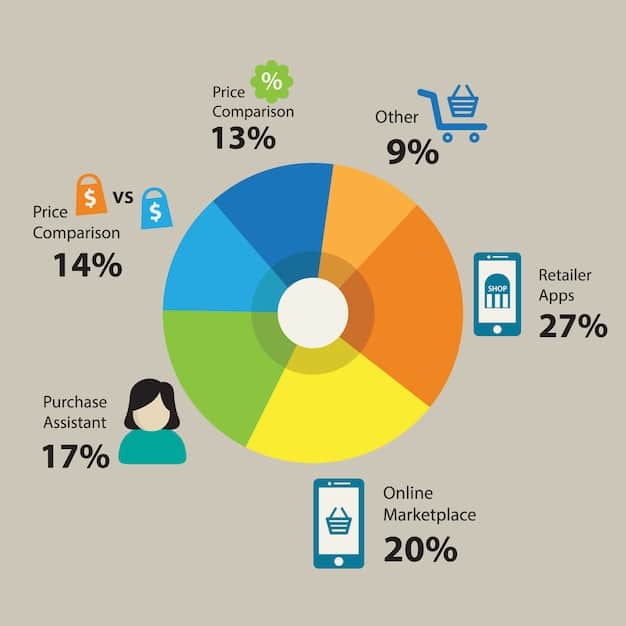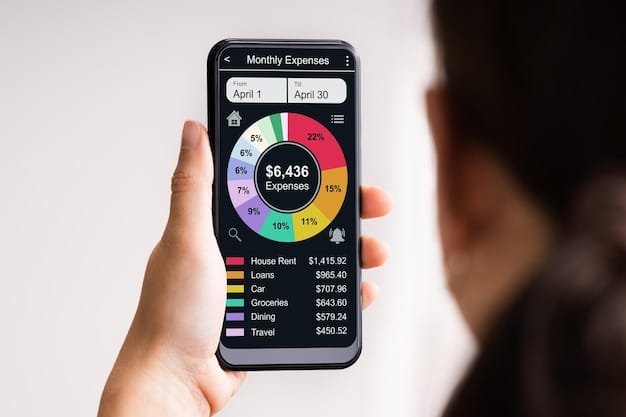Track Online Spending & Budget Leaks: Save $100+/Month

Tracking your online spending and identifying budget leaks is crucial for financial health; it allows you to understand where your money goes, identify areas for reduction, and potentially save $100 or more each month.
Are you wondering where all your money goes each month, especially with the ease of online shopping? Learning how to track your online spending and identify budget leaks (save $100+ per month) is the first step towards gaining control of your finances and achieving your financial goals.
Why Tracking Online Spending is Essential
Tracking your online spending might seem tedious, but it’s a powerful tool for understanding your habits and making informed financial decisions. Without a clear picture of where your money is going, it’s easy to overspend and miss opportunities to save.
Here are some compelling reasons to start tracking your online spending:
Gain Awareness of Spending Habits
Many of us are unaware of the small, recurring expenses that add up over time. Tracking helps you identify these “phantom” expenses, like subscription services you no longer use or impulse purchases that don’t align with your values.
Identify Budget Leaks
Budget leaks are small, often unnoticed expenses that drain your budget. These can include excessive delivery fees, unnecessary upgrades, or unplanned online purchases. By closely monitoring your transactions, you can pinpoint where these occur.
Make Informed Financial Decisions
With a clear understanding of your online spending, you can make more informed decisions about your budget. You can allocate resources more effectively, prioritize essential expenses, and set realistic savings goals.

- Enhanced Budgeting: Accurately allocate funds based on actual spending patterns.
- Reduced Financial Stress: Gain control and reduce anxiety about money.
- Improved Savings: Free up funds to reach savings goals faster.
Ultimately, tracking gives you the knowledge and power to make lasting positive changes to your financial well-being. It’s not about restricting yourself entirely, but about making conscious choices.
Effective Methods for Tracking Online Spending
There are several effective methods for tracking your online spending, each with its own advantages and suitability for different preferences. Choosing the method that fits your lifestyle is key to consistent tracking.
Here are some practical approaches:
Using Budgeting Apps
Budgeting apps are designed to automate the tracking process and provide insights into your spending habits. Many apps connect directly to your bank accounts and credit cards, automatically categorizing transactions.
Spreadsheet Tracking
Creating a spreadsheet allows for complete customization and control over your data. You manually enter each transaction, categorize it, and track your spending over time. This method offers flexibility but requires more manual effort.
Reviewing Bank and Credit Card Statements
Regularly reviewing your bank and credit card statements is a simple way to track your spending. Look for patterns, identify recurring charges, and categorize your transactions manually.
- Mint: A popular app that aggregates financial accounts and provides spending reports.
- YNAB (You Need a Budget): A budgeting system that emphasizes planning and goal-setting.
- Personal Capital: Offers investment tracking alongside budgeting features.
Each method offers a unique approach to tracking your online expenses. Experiment to see which one aligns with your organizational style and frequency of spending.
How to Identify Common Budget Leaks in Online Spending
Budget leaks can quietly drain your financial resources if left unchecked. Identifying these subtle expenses is crucial for plugging the holes in your budget. The more aware you are, the quicker you can make adjustments and recover savings.
Common budget leaks include:
Subscription Services
Subscriptions are a major source of budget leaks. Many people sign up for free trials and forget to cancel before being charged. Others pay for services they rarely use. Review your subscriptions to identify and cancel those that aren’t providing value.
Impulse Purchases
The ease of online shopping makes impulse purchases tempting. Before you know it, those little wants can take a significant hit on your budget. Implement a ‘waiting period’ before making non-essential purchases.
Shipping Costs
Shipping and delivery fees can add up quickly, particularly with frequent online orders. Look for ways to consolidate purchases, use free shipping offers, or consider subscription services that offer free shipping.

- Audit Subscriptions: Review and cancel unused or underutilized subscriptions.
- Delay Impulse Buys: Wait 24-48 hours before making non-essential purchases.
- Consolidate Orders: Combine purchases to minimize shipping costs.
Detecting where your money leaks is an essential step in improving cash flow. By taking action on these leaks, you can redirect funds back to your long term financial goals.
Strategies to Cut Online Spending and Save Money
Once you’ve identified your budget leaks, the next step is to implement strategies to cut your online spending and save money. These changes don’t have to be drastic; even small adjustments can make a big difference.
Here are some strategies worth considering:
Create a Budget and Stick to It
Creating a budget can help you to prioritize your expenses and make sure that you’re not overspending. Set spending limits for various categories, such as online shopping, entertainment, and food delivery.
Use Cash-Back and Rewards Programs
Take advantage of cash-back and rewards programs offered by credit cards and online retailers. These programs can help you earn rewards on your purchases, which you can then use to offset future spending.
Shop Around and Compare Prices
Before making a purchase, take the time to shop around. Compare prices from different retailers to make sure that you’re getting the best deal. You can also use price comparison websites and apps to help you find the lowest prices.
These actions will assist in shaping better spending habits. Adopting a money saving attitude helps more than your budget – it builds future financial security.
Tools and Apps to Simplify Online Spending Tracking
Fortunately, there are various tools and apps available that can simplify the process of tracking your online spending. These resources not only make it easier to monitor where your money is going but also offer valuable insights and recommendations to improve your financial habits.
Here are some useful options:
Mobile Budgeting Apps
Mobile budgeting apps like Mint, YNAB, and Personal Capital provide a comprehensive view of your finances, automate transaction tracking, and offer insights into your spending patterns.
Browser Extensions for Price Comparison
Browser extensions like Honey and Rakuten automatically find and apply coupon codes and cash-back offers while you shop online, helping you save money on every purchase.
Spending Tracker Apps
Simple spending tracker apps allow you to manually enter your transactions and categorize them. These apps are useful for those who prefer a more hands-on approach.
- Automated Tracking: Connect accounts for hands-free transaction monitoring.
- Spending Insights: Get detailed reports and analysis of where your money goes.
- Savings Opportunities: Discover coupons, cash-back offers, and discounts.
Using these apps can lead to better management of online spending and the potential freeing-up of savings. Embrace those tools which best resonate with your financial tracking style.
Setting Financial Goals to Motivate Spending Control
Without clear financial goals, it’s easy to lose sight of your priorities and overspend on non-essential items. Setting specific, measurable, achievable, relevant, and time-bound (SMART) financial goals can provide the motivation you need to control your online spending and achieve financial stability.
Here’s how to set effective financial goals:
Define Specific Goals
Clearly define what you want to achieve, such as saving for a down payment on a house, debt repayment, or retirement. Vague goals like “save more money” are less motivating than specific goals with concrete targets.
Make Goals Measurable
Quantify your goals with specific numbers and deadlines. For example, instead of saying “pay off debt,” aim to “pay off $5,000 in credit card debt within 12 months.”
Ensure Goals are Realistic
Set goals that are challenging but achievable. Unrealistic goals can lead to discouragement and abandonment. Consider your current financial situation and resources when setting your targets.
- SMART Goals: Utilize the SMART framework to define clear, actionable goals.
- Visual Reminders: Keep your goals visible (e.g., vision board, notes) to stay motivated.
- Celebrate Milestones: Acknowledge and celebrate each achievement to maintain momentum.
When you have clear goals and a plan to achieve them, you’re more focused on monitoring your spending and less likely to engage in impulse purchases.
| Key Point 🔑 | Brief Description 📝 |
|---|---|
| Track Spending 📈 | Monitor online transactions to identify where money goes. |
| Identify Leaks 🔍 | Find recurring subscriptions, impulse buys, and shipping costs. |
| Set Goals 🎯 | Define specific, measurable financial objectives for motivation. |
| Use Tools 📱 | Employ budgeting apps and browser extensions for easier tracking. |
Frequently Asked Questions (FAQ)
▼
Tracking online spending helps you understand your spending habits, identify potential savings, and make better financial decisions. It provides insights into where your money is going.
▼
Common budget leaks include unused subscriptions, impulse purchases, excessive delivery fees, and forgotten free trials. These small expenses add up over time, impacting your budget.
▼
Create a budget by listing your income and expenses, setting spending limits for each category, and tracking your actual spending to ensure you stay within your budget. Budgeting apps can simplify this process.
▼
Several budgeting apps (like Mint and YNAB), spreadsheet templates, and browser extensions (like Honey) can help you track your expenses, identify savings opportunities, and make informed financial choices.
▼
Having financial goals, such as saving for a down payment or paying off debt, provides the motivation to control spending. These goals help you prioritize expenses and make more conscious purchasing decisions.
Conclusion
Taking control of your online spending is attainable with diligence and a smart approach. By understanding your spending, utilizing readily available tools and creating clear financial objectives, you can begin your path to achieving better financial health and generating extra savings of $100 plus each month.





